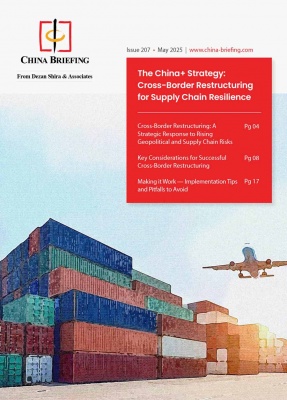China Clarifies IIT Rules Regarding Share Capital Increase after Equity Acquisition
May 24 – China’s State Administration of Taxation (SAT) promulgated the “Announcement on Issues Concerning Individual Income Tax (IIT) on Individual Investors’ Post-Equity Acquisition Increase of Share Capital Converted from the Previously Accumulated Surplus of the Enterprise” (SAT Announcement [2013] No. 23, hereinafter referred to as “Announcement 23”) on May 7, 2013, which will enter into force on June 7, 2013.
The purpose of Announcement 23 is to clarify the IIT liability of individual investors who acquire 100 percent equity from an enterprise and then convert the enterprise’s accumulated surplus into share capital after the transaction. Accumulated surplus includes capital reserves, surplus reserves and undistributed profits recorded in the accounting book of the acquired enterprise prior to the transaction. The relevant IIT treatment is as follows:
A. If the transaction price of the equity acquisition is (i) not less than the value of the net assets of the enterprise, and (ii) includes the total value of the accumulated surplus, then the new shareholders would not be subject to IIT for the increased portion of their capital share converted from the accumulated surplus.
B. If the transaction price of the equity acquisition is less than the value of net assets of the enterprise, then:
- Individual investors would not be subject to IIT for the portion of the increase in their capital share converted from the portion of the accumulated surplus that has been included in the transaction price, i.e., the difference between the transaction price and the original paid-in capital;
- However, individual investors would still need to pay IIT for the portion of the increase in their capital share converted from the portion of the accumulated surplus that has not been included in the transaction price, i.e., the difference between the value of the stockholders’ equity of the enterprise and the transaction price. This portion will be subject to IIT as “interests, dividends and bonuses.”
Announcement 23 requires new shareholders to convert the taxable part of the accumulated surplus into share capital before converting the tax exempt part.
Example
China’s SAT provides the example below to illustrate the above rules:
At the time of transaction, Enterprise A has RMB80 million in assets, including RMB30 million in liabilities and RMB50 million in stockholders’ equity. The RMB50 million in stockholders’ equity includes paid-in capital of RMB10 million and RMB40 million in accumulated surplus. Several individual investors (the new shareholders) purchased 100 percent shares of Enterprise A at a transaction price of RMB45 million. After the acquisition, Enterprise A converts the RMB40 million in accumulated surplus into paid-in capital.
Equation 1
- Portion exempt from IIT = Transaction price – original paid-in capital
- Portion exempt from IIT = RMB45 million – RMB10 million = RMB35 million
Equation 2
- Portion subject to IIT = Stockholders’ equity value – transaction price
- Portion subject to IIT = RMB50 million – RMB45 million = RMB5 million
After subtracting RMB10 million in paid-in capital from the RMB45 million transaction price, the remaining RMB35 million corresponds to the RMB40 million in accumulated surplus the new shareholders acquired. This means that, of the RMB40 million in accumulated surplus, RMB35 million has been included in the transaction price, but the remaining RMB5 million has not. Therefore, the RMB35 million portion is IIT exempt, while the RMB5 million portion should be taxed as “income from interests, dividends, and bonuses.”
According to SAT, the rationale behind this treatment is to ensure that the new shareholders are not unfairly subject to double taxation on the portion of the consideration they paid in exchange for the accumulated surplus, and to ensure that tax treatment of profit distribution prior to equity transfer by the original shareholders is consistent with that of profit distribution by the new shareholders after equity transfer.
According to Announcement 23, when the new shareholders transfer the equity, the new tax base of the equity share of the enterprise is the consideration and relevant taxes actually paid by the individual investors during the acquisition.
In addition, the enterprise should report the changes in shareholders and share capital, the accumulated surplus prior to the equity transaction, the increase in share capital converted from the previous accumulated surplus, and the tax collection status to the competent tax authority within 15 days of the following month since the conversion.
Dezan Shira & Associates is a specialist foreign direct investment practice, providing corporate establishment, business advisory, tax advisory and compliance, accounting, payroll, due diligence and financial review services to multinationals investing in emerging Asia. Since its establishment in 1992, the firm has grown into one of Asia’s most versatile full-service consultancies with operational offices across China, Hong Kong, India, Singapore and Vietnam as well as liaison offices in Italy and the United States.
For further details or to contact the firm, please email china@dezshira.com, visit www.dezshira.com, or download the company brochure.
You can stay up to date with the latest business and investment trends across Asia by subscribing to Asia Briefing’s complimentary update service featuring news, commentary, guides, and multimedia resources.
Related Reading
 The China Tax Guide: Tax, Accounting and Audit (Sixth Edition)
The China Tax Guide: Tax, Accounting and Audit (Sixth Edition)
This edition of the China Tax Guide, updated for 2013, offers a comprehensive overview of the major taxes foreign investors are likely to encounter when establishing or operating a business in China, as well as other tax-relevant obligations. This concise, detailed, yet pragmatic guide is ideal for CFOs, compliance officers and heads of accounting who need to be able to navigate the complex tax and accounting landscape in China in order to effectively manage and strategically plan their China operations.
 M&A Regulations in China
M&A Regulations in China
In this issue of China Briefing Magazine, we focus on the regulatory issues affecting cross-border M&As, and the key tax points foreign investors should be aware of when conducting M&As involving domestic Chinese companies. We also address the key aspects of transfer pricing, corporate restructuring exemption, and valuation as they relate to M&As.
- Previous Article China Issues Announcement on Value-added Tax Declaration
- Next Article China Reaches Deal With U.S. Audit Regulators


























